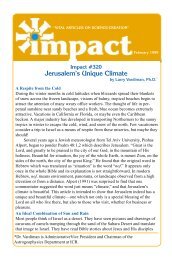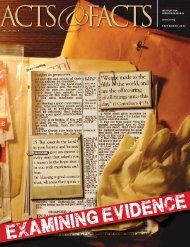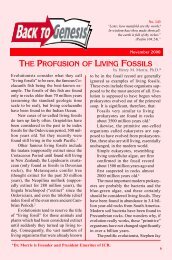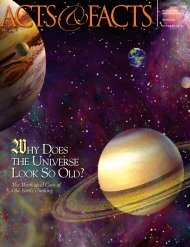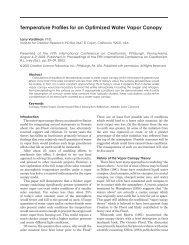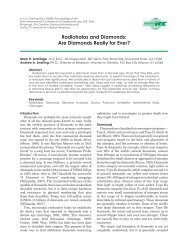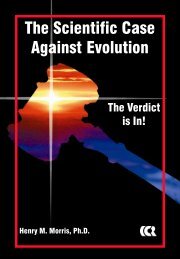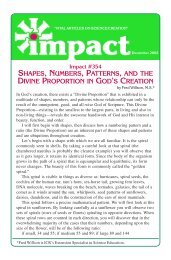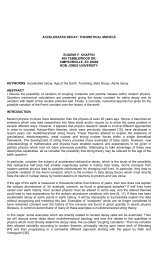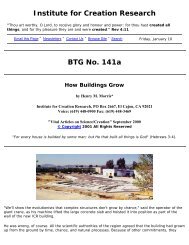Number <strong>of</strong> Samples654321Coal 14 CAMS ResultsMean: 0.247Std dev: 0.10900 0.1 0.2 0.3 0.4 0.5 0.6 0.7Percent Modern CarbonFigure 8. Histogram representation <strong>of</strong> AMS 14 C analysis <strong>of</strong> ten coal samples undertaken by<strong>the</strong> RATE 14 C research project.TENTATIVE CONCLUSIONSAt this point in <strong>the</strong> RATE research several tentative conclusions are beginning to emerge, based on <strong>the</strong>literature searches, <strong>the</strong>oretical studies, <strong>and</strong> laboratory findings. Although some are firmer than o<strong>the</strong>rs,<strong>the</strong> following conclusions are likely to be in <strong>the</strong> final report. There will likely also be additionalconclusions which are too early to include at this time. The tentative conclusions will only be reportedhere in outline <strong>for</strong>m. More detail <strong>and</strong> justifications <strong>for</strong> most <strong>of</strong> <strong>the</strong>se conclusions are discussed in <strong>the</strong>referenced papers in <strong>the</strong>se Proceedings.1. Conventional radioisotope dating methods are unreliable.a. Discordance among different dating methods is common.b. Key assumptions underlying radioisotope dating methods are untenable.c. Mixing <strong>of</strong> mantle <strong>and</strong> crustal sources also mixes <strong>the</strong>ir isotopic signatures.d. Residual 14 C appears to be present in all fossil biogenic material.2. Massive nuclear decay has occurred in rocks.a. Large quantities <strong>of</strong> daughter elements like Pb, He, <strong>and</strong> Ar are present.b. Many <strong>of</strong> <strong>the</strong> daughter elements are in proximity to <strong>the</strong> parent elements.c. Fission tracks <strong>and</strong> radiohalos are numerous.3. Isotopic mixing between <strong>the</strong> <strong>earth</strong>’s mantle <strong>and</strong> crust has occurred.a. Lava flows exhibit isotopic characteristics <strong>of</strong> <strong>the</strong> mantle.b. Isotopic data suggest basalts were generated from melting <strong>of</strong> old mantle.c. Isotopic data also suggest basalt magmas were contaminated during <strong>the</strong>ir ascent.4. Residual He <strong>and</strong> radiohalos suggest recent nuclear decay.a. Large quantities <strong>of</strong> He are still present in many granites today.b. If He was <strong>for</strong>med millions <strong>of</strong> years ago, it should have already escaped.c. Experimentally-determined diffusion rates <strong>of</strong> He agree with recent production <strong>of</strong> He.d. Po halos appear to have <strong>for</strong>med during rapid cooling <strong>of</strong> granite plutons during <strong>the</strong> Flood(eliminating millions <strong>of</strong> years).e. If <strong>the</strong> cooling <strong>of</strong> <strong>the</strong> plutons was rapid, <strong>the</strong>n metamorphism was also rapid during <strong>the</strong> Flood(eliminating millions <strong>of</strong> years).5. Massive nuclear decay, radiohalos, helium diffusion, <strong>and</strong> deep 14 C all imply accelerated decay.a. Massive nuclear decay requires higher decay rates be<strong>for</strong>e <strong>the</strong> present.b. Radiohalos <strong>for</strong>med during <strong>the</strong> Flood require decay rates higher than observed today.c. Helium diffusion data imply <strong>the</strong> decay occurred within thous<strong>and</strong>s <strong>of</strong> years ago.d. Deep 14 C implies <strong>the</strong> decay occurred within thous<strong>and</strong>s <strong>of</strong> years ago.6. Studies in <strong>the</strong>oretical physics suggest accelerated nuclear decay can occur.a. Variation in compactified dimensions could affect coupling constants.b. Consequent variation in coupling constants could cause accelerated decay.c. Changes in potential well depth change <strong>the</strong> α-particle wave function.d. Changes in <strong>the</strong> α-particle wave function change decay half-lives.
SUMMARYThe basic conclusion <strong>of</strong> this research is that conventional radioisotopic dating methods areunreliable. The chief reason is that uni<strong>for</strong>mitarianism is not a legitimate model <strong>of</strong> <strong>earth</strong> history.Observational evidence supports <strong>the</strong> recent occurrence <strong>of</strong> a global catastrophic Flood. Because <strong>the</strong><strong>earth</strong> has suffered a major tectonic catastrophe corresponding to <strong>the</strong> Genesis Flood, <strong>the</strong> uni<strong>for</strong>mitarianassumptions that are applied to obtain <strong>age</strong> estimates from radioisoptopic data are simply not true.Intermediate results from RATE support a young-<strong>earth</strong>, catastrophic, creationist model.Two remaining years in <strong>the</strong> research phase will be needed to complete <strong>the</strong> analysis <strong>of</strong> samples yetbeing processed <strong>and</strong> <strong>the</strong>oretical studies still being made. By <strong>the</strong> end <strong>of</strong> <strong>the</strong> research phase <strong>the</strong> finalreport should be based on a larger data set than was available <strong>for</strong> this paper. A few research projectswithin RATE such as Fission Tracks <strong>and</strong> Biblical Word Studies which have not been discussed in thispaper are also expected to contribute to <strong>the</strong> final report. It is apparent that significant progress has beenmade in explaining <strong>the</strong> presence <strong>of</strong> large quantities <strong>of</strong> nuclear decay products in a young-<strong>earth</strong>timeframe. The evidence should be stronger <strong>and</strong> more convincing by <strong>the</strong> time <strong>the</strong> research project iscompleted in 2005. We also hope that by <strong>the</strong>n a more detailed young-<strong>earth</strong> creationist model <strong>of</strong> <strong>the</strong>history <strong>of</strong> radioactive decay will also have been developed.ACKNOWLEDGMENTSAppreciation is expressed to <strong>the</strong> many donors who contributed financially to RATE. Los Alamos NationalLaboratory provided samples <strong>of</strong> Jemez granodiorite <strong>for</strong> chemical <strong>and</strong> radioisotope analyses <strong>and</strong> Gr<strong>and</strong>Canyon National Park <strong>and</strong> Yosemite National Park granted permission to Drs. Austin <strong>and</strong> Snelling tocollect rock samples.REFERENCES[1] Baumgardner, J.R., Snelling, A.A., Humphreys, D.R. <strong>and</strong> Austin, S.A., Measurable 14 C inFossilized Organic Materials: Confirming <strong>the</strong> Young Earth <strong>Creation</strong>-Flood Model,Proceedings <strong>of</strong> <strong>the</strong> Fifth International Conference on <strong>Creation</strong>ism, R. Ivey, Editor, 2003, <strong>Creation</strong>Science Fellowship, Pittsburgh, PA, this volume.[2] Chaffin, E.F., Theoretical Mechanisms <strong>of</strong> Accelerated Radioactive Decay, Radioisotopes <strong>and</strong><strong>the</strong> Age <strong>of</strong> <strong>the</strong> Earth: A Young-Earth <strong>Creation</strong>ist <strong>Research</strong> Initiative, L. Vardiman, A.A. Snelling<strong>and</strong> E.F. Chaffin, Editors, 2000, <strong>Institute</strong> <strong>for</strong> <strong>Creation</strong> <strong>Research</strong>, El Cajon, CA <strong>and</strong> <strong>Creation</strong><strong>Research</strong> Society, St. Joseph, MO, pp. 303-331.[3] Chaffin, E.F., Accelerated Decay: Theoretical Models, Proceedings <strong>of</strong> <strong>the</strong> Fifth InternationalConference on <strong>Creation</strong>ism, R. Ivey, Editor, 2003, <strong>Creation</strong> Science Fellowship, Pittsburgh, PA,this volume.[4] Davies, J.H. <strong>and</strong> Stevenson, D.J., Physical Model <strong>of</strong> Source Region <strong>of</strong> Subduction ZoneVolcanics, Journal <strong>of</strong> Geophysical <strong>Research</strong>, 97(1992), pp. 2037-2070.[5] Gamble, J.A., Wood, C.P., Price, R.C., Smith, I.E.M., Stewart, R.B. <strong>and</strong> Waight, T., A Fifty YearPerspective <strong>of</strong> Magmatic Evolution on Ruapehu Volcano, New Zeal<strong>and</strong>: Verification <strong>of</strong>Open System Behaviour in an Arc Volcano, Earth <strong>and</strong> Planetary Science Letters, 170(1999),pp. 301-314.[6] Gentry, R.V., Glish, G.J. <strong>and</strong> McBay, E.H., Differential Helium in Zircons: Implications <strong>for</strong>Nuclear Waste Man<strong>age</strong>ment, Geophysical <strong>Research</strong> Letters, 9:10 (1982), pp. 1129-1130.[7] Giem, P., Carbon-14 Content <strong>of</strong> Fossil Carbon, Origins, 51(2001), pp. 6-30.[8] Humphreys, D.R., Accelerated Nuclear Decay: A Viable Hypo<strong>the</strong>sis?, Radioisotopes <strong>and</strong> <strong>the</strong>Age <strong>of</strong> <strong>the</strong> Earth: A Young-Earth <strong>Creation</strong>ist <strong>Research</strong> Initiative, L. Vardiman, A.A. Snelling <strong>and</strong>E.F. Chaffin, Editors, 2000, <strong>Institute</strong> <strong>for</strong> <strong>Creation</strong> <strong>Research</strong>, El Cajon, CA <strong>and</strong> <strong>Creation</strong> <strong>Research</strong>Society, St. Joseph, MO, pp. 333-379.[9] Humphreys, D.R., Austin, S.A., Baumgardner, J.R. <strong>and</strong> Snelling, A.A., Helium Diffusion RatesSupport Accelerated Nuclear Decay, Proceedings <strong>of</strong> <strong>the</strong> Fifth International Conference on<strong>Creation</strong>ism, R. Ivey, Editor, 2003, <strong>Creation</strong> Science Fellowship, Pittsburgh, PA, this volume.



